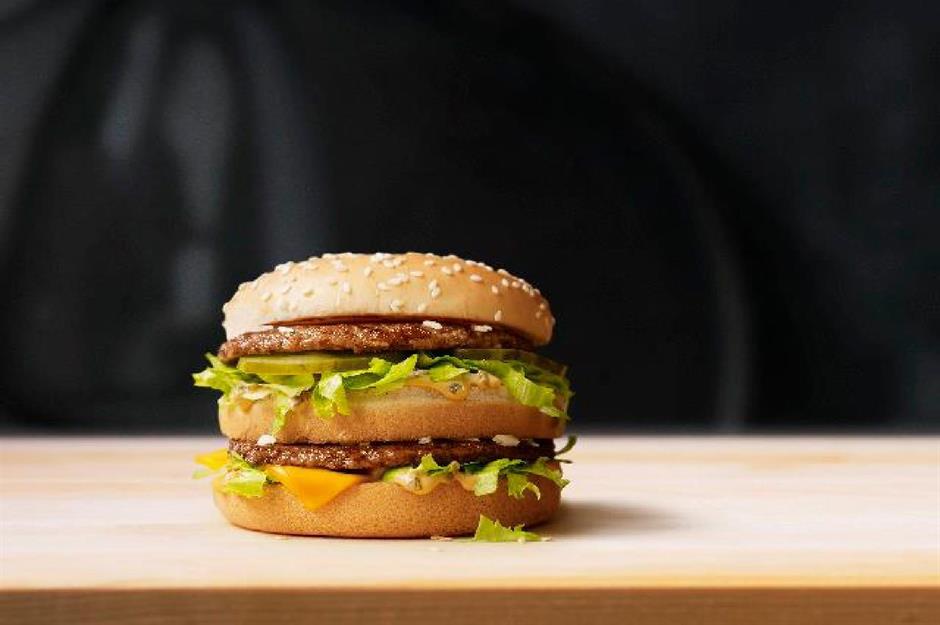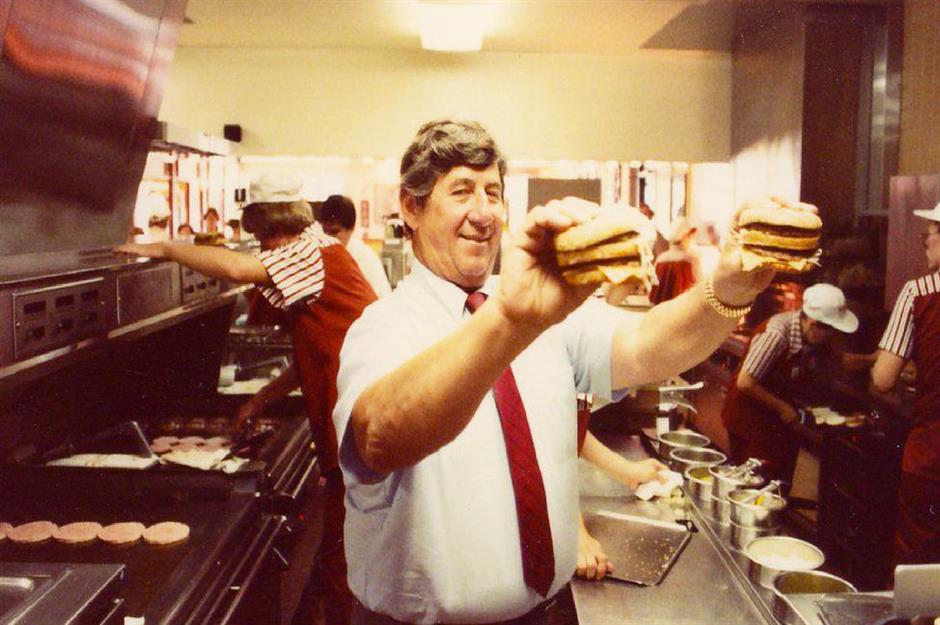The incredible history of the Big Mac
A fast-food icon through the decades
A fast-food heavyweight
The seed is sown
After a decade of being in business, master franchisee Delligatti came up with a smart plan to keep punters pouring in. His key customers were male workers from the nearby steel mills and, after a hard shift, they reportedly weren't satisfied by the smaller burgers Delligatti had to offer (the classic cheeseburger pictured, for example). Taking inspiration from the whopping sandwiches sold at diners nearby, Delligatti developed the idea for a teetering "double-decker" burger.
A bump in the road
The Big Mac is born
There was one condition: Delligatti could whip up his whopping hamburger, but only if he made it with ingredients and products that were already part of the McDonald's portfolio. Ever the maverick, though, Delligatti eschewed the restaurant's existing bread in favour of a double-sliced, sesame-seed-topped bun sourced from a local bakery.
The Big Mac is born
Delligatti spent a few weeks fine-tuning his recipe – including developing the burger's tangy, creamy, signature 'special sauce' – and was ready with his titanic creation by 1967. He began selling the burger – made up of two beef patties, the 'special sauce', cheese, pickles, onions and lettuce, cased together in the sesame-seed bun – at his Uniontown store that same year. It went for 45 cents a time.
The evolution of an icon
The Big Mac wasn't always the 'Big Mac' though. The burger began its life under several decidedly less catchy names, including the Blue Ribbon Burger and The Aristocrat. Young advertising secretary Esther Rose is widely credited as the brains behind the burger's eventual and enduring name: the Big Mac.
The Big Mac goes nationwide
The beastly burger was a roaring success, and Delligatti’s franchise thrived. And, in a complete 180, McDonald's bosses decided to roll out the Big Mac at stores across the country. In 1968, just one year after Delligatti began selling the burger at his own stores, the Big Mac was made available all over the States.
The Big Mac takes over the world
With the Big Mac enjoying something of a cult status in America, it wasn't long before it found its way across the pond too. It not only graced international menus, but also found its way onto advertising posters, being proudly described as "a meal disguised as a sandwich". The "hot and hearty" Big Mac became a favourite the world over.
The Big Mac's special sauce
While today's Big Mac is almost identical to what it was in the 1960s, the burger's famous special sauce has had some tinkering over the years. It's often dubbed a closely guarded secret, but the basic recipe of the sauce – which includes mayonnaise, sweet-pickle relish and yellow mustard – has actually been shared by McDonald's chefs online over the years. Originally two versions of the sauce existed, but the recipe was finessed into a single, mouthwatering recipe in 1972. It was altered once more in 1991, but had returned to its original glory by 2004.
See more top-secret recipes we'd love to get our hands on here
The birth of Officer Big Mac
The Big Mac's success was helped along by plenty of memorable marketing campaigns too. In the early 1970s, McDonaldland – a fantasy world inhabited by a motley band of fictional fast-food-themed characters – was born. Among them was the googly eyed Officer Big Mac (pictured back left), who wore a bright blue uniform and a teensy police hat perched atop his beef-and-bread head.
The Big Mac jingle
Fast-forward just a few years, and the Big Mac's most iconic advertising campaign was created. In 1974, a New York advertising agency came up with a catchy jingle that simply listed out all of the Big Mac's ingredients in one breathless, sing-songy line: "two all beef patties, special sauce, lettuce, cheese, pickles, onions, on a sesame-seed bun". It would serve as an earworm for decades to come.
The Big Mac Index
By the 1980s the Big Mac was so prolific that it began to be used as an economic tool. The Big Mac was employed by The Economist as an easy-to-understand measure of purchasing power parity – ie. identical goods are used to understand the differences in world currencies. The near global availability of the Big Mac made it the perfect item for this kind of comparison – and so the Big Mac Index was born. Though it was initially intended as a bit of lighthearted fun, "burgernomics" remains a globally recognised approach today.
Bigger is better
A decade later, the Big Mac became bigger still. News articles hailed the monstrous Mega Mac as "the burger to end all burgers", when it came onto the scene in the 1990s. The Mega Mac – which also exists as the Double Big Mac in some parts of the world today – is just like the original, except you get a belly-busting four beef patties instead of two.
The Big Mac celebrates 25 years
In 1993, there were celebrations of the beloved Big Mac's 25th birthday. By this point in time, it's reported that a tremendous 14 billion Big Macs had been sold. Pittsburgh, near the Big Mac's origin place of Uniontown, went particularly hard on the festivities. Then-Mayor Sophie Masloff even proclaimed the city “Big Mac City, U.S.A.”.
Spin-offs from a classic
While the classic burger is still known and loved internationally, that hasn't stopped some McDonald's restaurants from dreaming up tweaks and twists that will make Big Mac purists squirm. Shake-ups of the original include a Chicken Big Mac, which was on menus in Australia for a time, and the Denali Mac, only available in (you guessed it) Alaska. The latter was launched in 2006 and is one for big eaters, with larger beef patties and more special sauce.
The Big Mac Museum opens
A 14-foot (4.3m) model Big Mac and oodles of displays on the legendary burger can be found at the Big Mac Museum in North Huntingdon, Pennsylvania, not far from Uniontown. The quirky museum opened in 2007 to honour the enduring fast-food phenomena and its founder – it chronicles the Big Mac's history and displays packaging and other relics from across the decades.
A sad day in Big Mac history
Burger lovers from Pennsylvania and beyond mourned the loss of a fast-food luminary when Jim Delligatti passed away at the age of 98 in 2016. In a statement issued by McDonald's, the Big Mac inventor was described as "a legendary franchisee within the McDonald's system".
Delligatti's love for the Big Mac
Delligatti reportedly never made any real money from his invention: in his own words "all [he] got was a plaque". But that didn't dim the late inventor's love for his creation – in fact he apparently ate at least one Big Mac per week, every week, throughout the whole of his long life.
Big Mac special sauce is bottled
At various points in history, McDonald's has sent its fans into a flurry by releasing bottles of its famous Big Mac special sauce. In 2015, for example, the bottled condiment went on sale in Australia, with one bottle climbing to thousands of dollars in an eBay bidding war. The bottled sauce hit Oz markets again for a limited time in 2019, so if you're a fan (and you're lucky enough to live Down Under), watch this space...
Introducing the Mac Jr and the Grand Big Mac
Come 2018, the Big Mac celebrated its 50th birthday – and in true McDonald's style the anniversary was marked with two tasty, limited-edition burgers. The Mac Jr was a dinky version of the original Big Mac, with a single patty but still plenty of that special sauce, while the Grand Big Mac was an enlarged offering with bigger patties and double the cheese. A nostalgic accompanying advert whisked viewers through the five decades the Big Mac had been in existence.
Happy 50th birthday to the Big Mac
The burger's big birthday was also celebrated with the release of MacCoins. In the US, participating McDonald's restaurants would give customers who bought a Big Mac a free MacCoin, which they could then exchange for another, free Big Mac. The coins were a nod to the Big Mac's unlikely role in economics – or "burgernomics" – as a result of the Big Mac index, and just an all-round treat for stalwart Big Mac lovers.
Now read about how America's fast food has changed over the last decade
Is bacon a streak too far?
Perhaps no other event in Big Mac history has caused such a stir: last year, McDonald's added bacon to its most iconic burger in a move that brought forward cries of dissent from Big Mac traditionalists all over. The Big Mac with Bacon saw several streaky rashers cased within the signature burger, whose composition hadn't changed at all in the UK since the 1960s. The hashtags #NotABigMac and #StillABigMac trended across social media, with McDonald's themselves leading the debate through a series of viral ad campaigns.
The Big Mac's legacy
By the Big Mac's 40th birthday, McDonald's were reportedly selling 550 million items of the burger each year – that's a whopping 17 per second. And though another decade has passed the burger remains a darling of the fast-food world. Billions have sold since the 1960s and it remains available in hundreds of countries worldwide. The nutritional value for each Big Mac does vary slightly, depending on that country's food laws, but you'd never know – they still taste the same.
Now discover the incredible story of how McDonald's conquered the world
The future of the Big Mac
Despite the Big Mac's legendary status, it faces some competition. In 2016, the Wall Street Journal reported that only one in five millennials had ever tried the mighty burger, their preference being gourmet offerings at hip, indie joints and healthier alternatives. So is the timeless burger's time up? One thing's for sure: whatever the future of the Big Mac, it has earned a firm place in fast-food history.
Here are 26 special McDonald's menu items from around the world that you might not have tried

